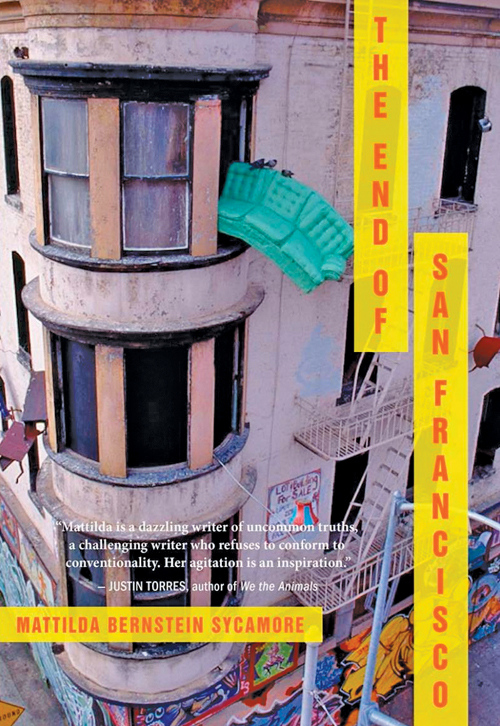Is Gay San Francisco Dead?

Mattilda Bernstein Sycamore
2013 • City Lights Publishers (citylights.com)
192 pages, $15.95, softcover
The need for freaks, outsiders, and queers.
by Kit van Cleave
Recently, an old friend called me from San Francisco. Born in Houston, he’d recently moved back here from New York City, then went on to California seeking work in theater or film. “There’s no more gay community here,” he said. “I’m really surprised and sad about this.”
“Congratulate the town,” I said. “It’s a result of success.” I explained my theory: When a minority group begins to win political power and influence, oppression is lifted. People don’t have to pack into ghettoes anymore, live underground, or stay out of public view. They are assimilated into the larger culture.
“Don’t you remember when Houston was divided by race and we had all those wonderful black barbecue restaurants? Ike and Tina Turner at the Almeda Ballroom? Black Houstonians aren’t limited to the wards anymore,” I said. “Perhaps you’re finding San Francisco liberated from homophobia.”
Books recently reviewed in OutSmart have been excellent discussions of the success of the gay civil rights movement, and how steps taken by group action led to gains in political strength. But they have seldom focused on the individuals who sparked this success—people who made a single-minded commitment to give up literally everything else in life to achieve their goal.
Mattilda Bernstein Sycamore, who identifies as genderqueer and uses the pronouns she and her, is one of those who, for a variety of reasons, spent her late teens and most of her adult life fighting for gay equality. In her most recent memoir, The End of San Francisco, she details her peripatetic life. Constantly on the move—from Boston to New York, New York to Frisco, Frisco to Seattle, back to New York, then Chicago—she was involved in creating, staging, and carrying out actions intended to shake up homophobic American society.
Her parents were both psychiatrists. Her father molested her early on, and there’s some evidence that her mother did as well. Sycamore’s latest memoir opens in rather conventional literary style, with her confronting her dying father about the abuse she suffered as a child. The remainder of the book details her adventures after arriving in San Francisco at age nineteen in 1992, seeking a place of gay refuge.
“I was searching for direct-action activists, freaks, and outsiders, queers and other maniacs trying to undo the violence of the world around us,” she told Alexis Coe of SF Weekly shortly after this latest book came out. Unable to find what she sought, she began collecting a group around her who would participate in direct action.
She’d already worked with ACT UP and assisted with Fed Up Queers in the late 1990s, and was host of the first Gay Shame event in New York, which was captured on film by Scott Berry in the documentary Gay Shame 98. Gay Shame San Francisco started in 2000, becoming an annual event dedicated to “exposing all hypocrites.”
Sycamore’s memoir tells of “a whole generation of queers who came to San Francisco to try and cope. We were scarred and broken and brutalized but determined to create something else, something we could live with, something we could call home or healing or even just help…. We were incest survivors, dropouts, whores, runaways, vegans, anarchists, drug addicts, sluts, activists, and freaks trying not to disappear.”
To survive on the streets, Sycamore became a sex worker, taking tricks from Craigslist, staying with friends, boyfriends, or women who were involved in political action. She set herself apart with pink hair and “club kid” attire, confronting those who wore suits and wanted to gentrify historically gay areas.
She was disturbed by much of the San Francisco gay life she found. She didn’t like the trendy S/M scene, and she was outraged by the way women, and especially “dykes,” were treated in “fag spaces.” Copious amounts of drugs and alcohol harmed her health (as did sleeping on the streets), and flinging herself about while constantly dancing at the clubs created pain from “what the specialists first called repetitive stress injury, then tendinitis, now fibromyalgia,” to the point where she could hardly hold a knife to chop vegetables.
Yet she continued to try to change society, traveling from event to event, city to city, meeting other activists, and learning how to work with others for change. Her two novels, Pulling Taffy (2003) and So Many Ways to Sleep Badly (2008), were followed by several anti-assimilationist anthologies. Now, free of all stimulants for over a decade, she resides in Seattle much of the time.
Sycamore successfully leads the reader through this fin-de-siècle late-1990s narrative, impressively continuing her fight for those whom society has denied.
Kit van Cleave is a freelance writer living in Montrose. She has published in local, national, and international media.










